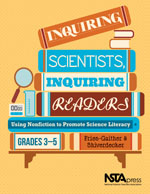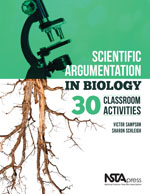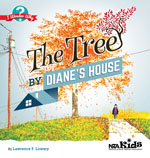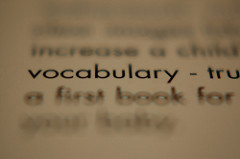What’s popular on NSTA’s website at the start of the school year
By Claire Reinburg
Posted on 2015-09-01
Browse the most popular books, e-books, and children’s trade books on NSTA’s website this month. Best wishes for the start of your school year!
Most Popular NSTA Press Books
Inquiring Scientists, Inquiring Readers: Using Nonfiction to Promote Science Literacy, Grades 3–5
A Head Start on Science: Encouraging a Sense of Wonder
Exemplary Science for Building Interest in STEM Careers
Using Physics Gadgets and Gizmos, Grades 9–12: Phenomenon-Based Learning
Most Popular NSTA Press e-Books
 Scientific Argumentation in Biology: 30 Classroom Activities (e-book)
Scientific Argumentation in Biology: 30 Classroom Activities (e-book)
Argument-Driven Inquiry in Life Science: Lab Investigations for Grades 6–8 (e-book)
Uncovering Student Ideas in Life Science, Volume 1: 25 New Formative Assessment Probes (e-book)
Most Popular NSTA Kids Books
 The Tree by Diane’s House: I Wonder Why
The Tree by Diane’s House: I Wonder Why
Browse the most popular books, e-books, and children’s trade books on NSTA’s website this month. Best wishes for the start of your school year!
Cell Structure and Function
Earth-Like Planets in the STEM Classroom
By Becky Stewart
Posted on 2015-08-31
On our vacation this year to Rockport, Massachusetts, we spent an hour one night watching the Perseid meteor shower. This is my favorite meteor shower because I can lay outside and not get cold too fast. The night sky is far darker on the end of Cape Ann than it is at home in Delaware, so it was a rewarding activity. There’s really nothing like staring at the stars and pondering the vastness of space to make you realize your puny human problems aren’t worth losing sleep over.
Ancient astronomers were the first to notice that most of the objects in the night sky moved in circular patterns. They also observed that a few did not move this way, and those they named wandering stars. The ancients’ wandering stars are what we today know as planets. Almost since humans recognized that Earth was also a planet, we have wondered whether there could be life in other parts of the universe. Recent technological advancements in astronomy have increased confidence in the probability that there are other forms of life in the universe.
Detection and Identification
The United States National Air and Space Administration (NASA) developed the ongoing Kepler mission to detect other planets in the universe and identify those that are similar to Earth in size, chemical composition, and orbit. Kepler is a spacecraft and photometer that continuously points at the same group of stars. The Kepler mission has identified a number of Earth-like planets in the habitable zones of stars. Since its launch on March 6, 2009, Kepler has identified 12 Earth-like planets in the habitable zones of stars. This is remarkable because the Kepler field of view is just a tiny portion of our galaxy, and the galaxy is a tiny portion of the universe.
Identifying a planet as potentially habitable isn’t enough to say if it is certainly so. The crucial element is water. The habitable zone for humans is identified as the orbital period around a star where liquid water might exist on the surface of the planets. The way that astrophysicists calculate a planet’s temperature is described here. The habitable zone for a star system can also be calculated.
A potentially habitable planet must also have an atmosphere. An atmosphere shields the planet’s surface from impacts and radiation, both of which can be hazardous to life. Some researchers have posited that some planets’ atmospheres could evolve over time. If a big planet forms in an outer orbit, with a rocky core and a thick gaseous atmosphere (similar to Neptune in our solar system), tidal forces in that star system could cause the planet to change and move over time. The star’s gravitational pull would stretch the planet into an ellipsoid and possible pull the planet closer to the star. The friction caused by these movements would cause heat, that could potentially drive surface volcanism or drive off lighter gasses in the atmosphere. If the planet has shifted into the star’s habitable zone, the leftover rocky core could be a habitable planet.
Are We Alone?
Although the existence of a number of planets in the habitable zone of other star systems has been proven, no one has yet seen these planets or captured images of them. There are a number of reasons why the search for other habitable planets matters to all of us. One is of course that the question of “Are we alone?” has fascinated humans since the recognition of Earth as a planet. Another is that the natural evolution of a star means that the Sun will eventually make life on Earth unsustainable, and we definitely don’t want to be in the neighborhood when that happens.
The recent discovery of Kepler 452b has been exciting for astrophysicists because its star is very similar to our Sun and the planet is of similar size, mass, and distance from its star as Earth. Its mass is likely about 5 times that of Earth because it is about 60% larger in diameter. The additional mass would provide many thousands of additional years of protection for the planet’s atmosphere from the increased energy of its star.
The relatively new field of astrobiology offers new opportunities for students interested in an interdisciplinary STEM career. Astrobiology degree programs are currently offered at a number of U.S. universities, including the University of Washington and the University of Hawaii. A comprehensive list of international educational resources can be found here.
Produced by the National Science Teachers Association (NSTA), science writer Becky Stewart contributes monthly to the Science and STEM Classroom e-newsletter, a forum for ideas and resources that middle and high school teachers need to support science, technology, engineering, and math curricula. If you enjoy these blog posts, follow Becky Stewart on Twitter (@ramenbecky).
Follow NSTA
Are Your Students Pretenders in a Digital World?
By Christine Royce
Posted on 2015-08-30
The Pretender was a television show many years ago just before the 21st century arrived where the main character Jarod took on new roles each and every week that required him to master any task required for that job. He was a pretender – stepping into a situation and having to learn how to problem solve on the spot, utilize information, and apply his learning in order to help out others.
Just after the turn of the century in 2001, Marc Prensky wrote an article titled Digital Natives, Digital Immigrants which coined the title terms of “digital native” and “digital immigrant.” Digital immigrants were those who were not born into technology and at some point needed to learn how to utilize technology in order to do exactly what Jarod had to do above – step into a situation, learn how to solve a problem on the spot, utilize information, and then apply it in order to help students learn in their own world.
By 2001, students who were in school from K- College had grown up with digital technology – okay not necessarily the digital technology we know today, but the leading edge digital technology that existed in 2001 and teachers were pretending to be digital in nature and learning on the spot. According to Beloit College’s Mindset List for 2005, which examines a series of statements around which a particular college graduation class grew up knowing, the college students who entered in the fall of 2001 – the so called digital natives, had the following attributes and characteristics (taken from the actual list) associated with their upbringing in general
- Hard copy has nothing to do with a TV show; a browser is not someone relaxing in a bookstore; a virus does not make humans sick; and a mouse is not a rodent (and there is no proper plural for it).
- A hacker is not just a kid who won’t stop fooling around.
- They were born the same year as the PC and the Mac.
- They have always had access to email.
- They have probably never used carbon paper and do not know what cc and bcc mean.
My first thought in looking at this list was wow – I’m not finding much about technology here – but then again that was nearly a decade and a half ago. I would think that given a vocabulary test today, almost all adults – whether digital natives or digital immigrants would have at least learned this particular vocabulary as it has seeped into our daily lives.
The most recent list that was just released focuses on this year’s incoming freshman class who will graduate in 2019. When reading this list, some interesting technology findings include:
- Google has always been there, in its founding words, “to organize the world’s information and make it universally accessible.”
- Email has become the new “formal” communication, while texts and tweets remain enclaves for the casual.
- They have grown up treating Wi-Fi as an entitlement.
- Cell phones have become so ubiquitous in class that teachers don’t know which students are using them to take notes and which ones are planning a party.
- Their parents have gone from encouraging them to use the Internet to begging them to get off it.
- If you say “around the turn of the century,” they may well ask you, “which one?”
- Teachers have always had to insist that term papers employ sources in addition to those found online.
In all fairness, some new vocabulary was also identified by Beloit College as relevant to this particular group – two examples include the following
- “Trolling” innocents on social media has always been uncharitable. (Cynical and bullying attacks on happy campers, preserved on the internet, may come back to haunt you.)
- They’ll know better than to text their professors “TL DR” about assignments. …and just hope their professor doesn’t scribble back to them, about their own papers: “TOO LONG: DIDN’T READ.”
 So, how does this walk down memory lane from Prensky to Beloit, tie in to the idea of being a pretender in a digital world? Well, a recent report from Change the Equation titled Does Not Compute: The High Cost of Low Technology Skills in the U.S.–and What We Can Do About It states that “Although American millennials are the first generation of “digital natives”–that is, people who grew up with computers and the internet–they are not very tech savvy.”
So, how does this walk down memory lane from Prensky to Beloit, tie in to the idea of being a pretender in a digital world? Well, a recent report from Change the Equation titled Does Not Compute: The High Cost of Low Technology Skills in the U.S.–and What We Can Do About It states that “Although American millennials are the first generation of “digital natives”–that is, people who grew up with computers and the internet–they are not very tech savvy.”
Wait just one minute– how can kids – those digital natives who have had nothing but technology their entire lives not be tech savvy happen? Well, Change the Equation in their study as part of the 2012 Programme for International Assessment of Adult Competencies (PIAAC), clarifies between using technology OFTEN versus using technology WELL. And there is the caveat – using technology does not mean they are using technology well or to solve a problem, thus you are not tech-savvy. The report brief states that “[u]sing technology for social networking, surfing the web, or taking selfies is a far cry from using it to solve complex problems at work or at home. Truly tech savvy people are able to fulfill the promise of technology, which is to help us be more productive, accelerate innovation, and overcome seemingly intractable challenges.”
I mentioned this report to my methods class – each of these pre-service teachers will become future middle school science teachers. I asked them if they thought they were tech savvy and provided the basis for the report. Okay – I felt old – some of them looked at me with their head cocked to one side like how could I say that – they are immersed in technology. So, being a noisy person – I asked them to take a few minutes and write a few sentences related to their feelings of being “tech savvy” in today’s world. I collected no names in order to protect the innocent. A short selection of their statements of “beliefs” regarding their tech savviness are below:
- While I love technology and all its possibilities, I’d say I’m not really tech savvy in ways I should be. When I worked in an office setting over the summer, I often found myself needing guidance in programs I thought I was familiar with (Word, Excel, etc.) to get the most out of them.
- I need to improve on my skills with technology because I use it mostly for entertainment. This [improving on technology skills] is necessary because most classrooms now use technology.
- I don’t really use technology to make tasks simpler.
- I think technology has its pros and cons. Many students that I will be teaching will be exposed to it at an early age.
- I like to think of myself as fairly tech-savvy. I think that technology when used properly and in small limited quantities can be very useful in the classroom. I don’t think it should be used too much because then I can see if becoming (1) a distraction or (2) too much of an issue for students who are not tech-savvy.
And there it was (with all due respect to my wonderful students), I was vindicated in asking my absurd question about them being tech savvy individuals and their answers hit on some of the key points in the Change the Equation report. An infogra
phic on the key findings in the report show that:
- Digital native does not mean tech savvy.
- The U.S. ranks dead last among 19 countries tested in this study.
- Tech savvy is an engine of opportunity. Tech savvy people end up doing better financially than non tech-savvy people.
- What we don’t know will hurt us.
- Our children deserve better and the ability to utilize technology to be more productive, accelerate innovation and overcome challenges needs to happen in our classrooms.
The last point is where we as educators come into the mix and help to show that being digital has come full circle. For the most part, there is a mix of educators who fall into either category of digital immigrant or digital native. But, every time new technology is introduced, the natives are not forced to learn as an immigrant would –by accommodation and assimilation into what we already knew. We, “digital immigrants” according to Prensky, learned to adapt to our environments even though we retained some of our initial thinking and strategies have now surpassed some of the digital natives in the type of thinking that this report calls for – application of technology to be productive and overcome challenges and be more focused on fulfilling the promise of technology rather than using it only for social networking. Therefore, it is our responsibility as an educator to help improve the digital native’s use of technology from simply using it often to using it well.
So, back to the original question – “are your students pretenders in a digital world?” and more importantly “what will you do about changing that in your classroom?”

The Pretender was a television show many years ago just before the 21st century arrived where the main character Jarod took on new roles each and every week that required him to master any task required for that job. He was a pretender – stepping into a situation and having to learn how to problem solve on the spot, utilize information, and apply his learning in order to help out others.
Science vocabulary: See it, say it
By Mary Bigelow
Posted on 2015-08-29
 How do you make vocabulary terms meaningful for students? I’m talking about really getting them to understand how the word or words are used in context. I feel students often just copy down a definition and never truly grasp how it relates to the topic at hand. —S., Missouri
How do you make vocabulary terms meaningful for students? I’m talking about really getting them to understand how the word or words are used in context. I feel students often just copy down a definition and never truly grasp how it relates to the topic at hand. —S., Missouri
Science students at all grade levels struggle with the vocabulary. They are SLLs—Science Language Learners. Textbooks and websites are full of specialized words that challenge our students. Some are technical and relate specifically to science (e.g., photosynthesis, thermodynamics, plate tectonics) while others have meanings in science that differ from common usage (e.g., theory, hypothesis, matter). Even the graphics in books and websites go beyond being decorative to include the language of science in tables, diagrams, graphs, captions, sidebars, and footnotes.
Sometimes we assume students understand a word, only to find out on an assessment that they are confused. For example, my middle school students often interchanged the words medium and median, and they didn’t realize that media was the plural of medium. No wonder the room was sometimes full of puzzled looks.
There are many strategies to help students with vocabulary, most of which involve reading and writing and focus on definitions. Common strategies include graphic organizers (such as the Frayer Model), word walls, student-created flash cards with definitions and pictures, vocabulary games, and notebook exercises.*
As you mentioned, students need to go beyond writing definitions to recognizing and using the words in context. Before reading, students are often given a list of words to define. I wonder what would happen if students looked at the text first to see the context in which the words were used. Can they use any context cues to figure out a definition before resorting to the glossary? (They may need some guidance on using cues. This could be an interesting action research topic.)
I had success with showing students how knowing common affixes and root/base words can help in figuring out what a word means. For example, when my students first encountered the word “photosynthesis,” I pointed out that “photo-” means “light,” and we brainstormed other words that started with photo and had something to do with light (photograph, photocopies, photojournalism). They had a page in their notebooks for these “word parts.”
In my experience, for students to understand and use new words, they also need to hear and say them. Sometimes what students wrote had little in common spelling-wise with the actual word. They could recognize the word in written material and match it to a definition, but many had difficulty pronouncing the word, generating the word in oral conversations, or using it in their writing.
I shared my dilemma with an elementary level colleague. He suggested that for more complex or unfamiliar words, have the students repeat the words several times out loud, emphasizing the syllables by clapping out each syllable: met-a-mor-pho-sis. I tried this with my middle and high school classes, and it did help them with pronunciation and spelling. (Be prepared for some eye-rolling at first with secondary students, so explain why you are asking them to do this.)
An article from the July/August 2013 issue of the Journal of College Science Teaching (JCST), “On the Road to Science Literacy: Building Confidence and Competency in Technical Language Through Choral Repetition,” shared an intriguing study on the effects of choral repetition on science learning in college science classes. They went further than my action research and did a more formal study of the strategy.*
In addition to the quantitative findings, the authors include perceptual feedback from the students. Among other findings, students reported that the strategy helped them remember the terms, it was a cue that the term was important, and it was something that would apply to other courses. “You are not as afraid to use the big words when you understand them better” and “the words or phrases that we repeated in class pop out more when you read it than if you never heard the word before…you would probably just gloss over it.” This is a simple strategy that requires no professional development or materials.
I’d be interested in hearing from you on any strategies you find useful!
* I’ve created a Learning Resource Collection–—Vocabulary: The Language of Science—with articles from NSTA publications and other websites on the topic, as well as the JCST article mentioned above.
Related NSTA blogs:



